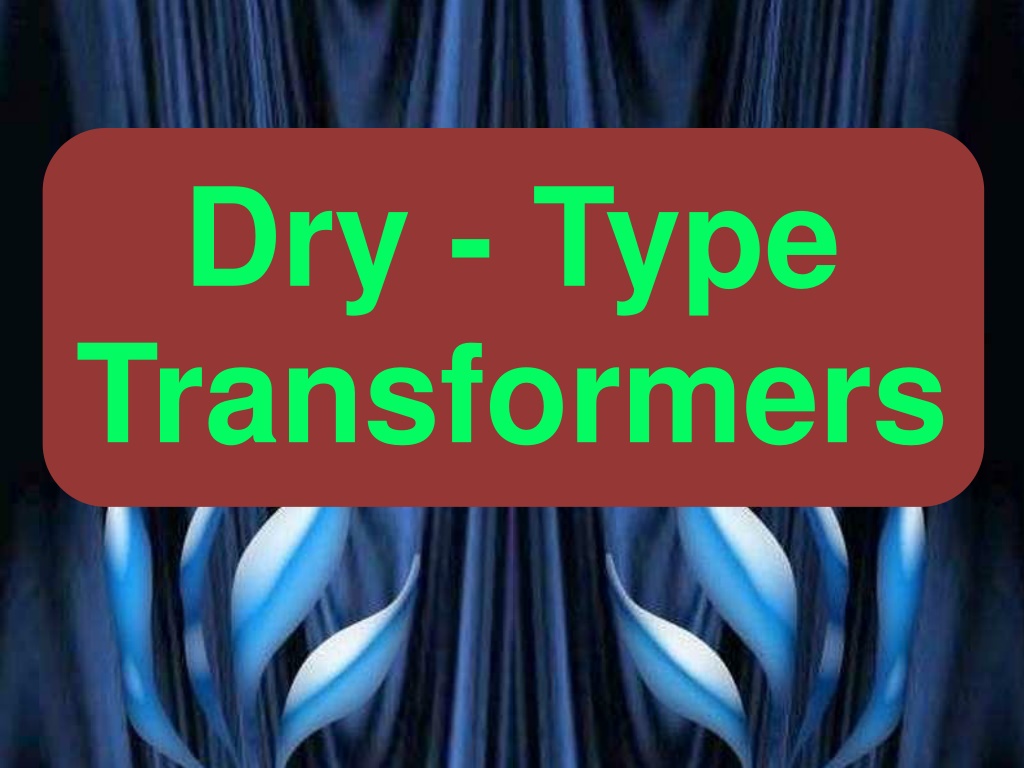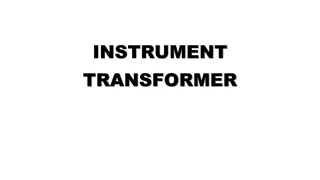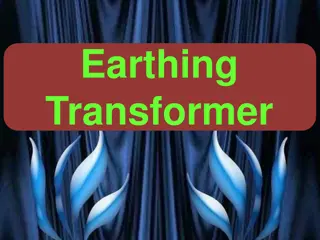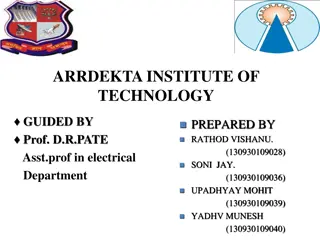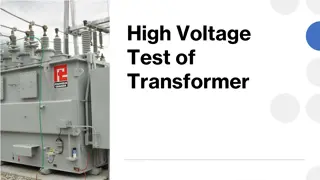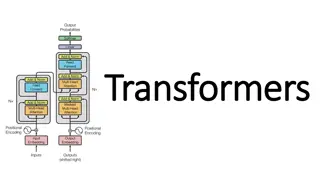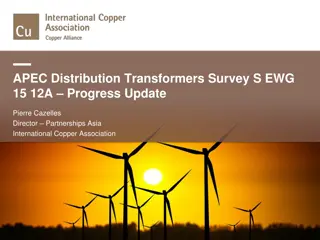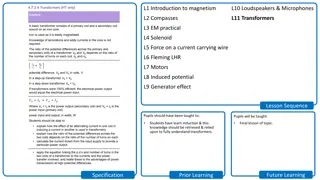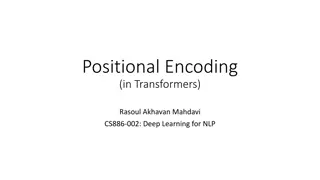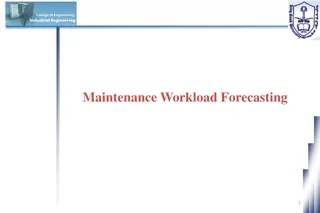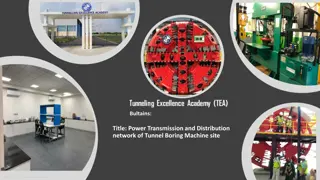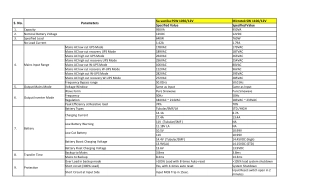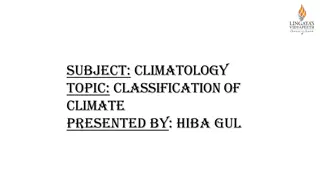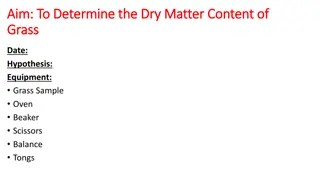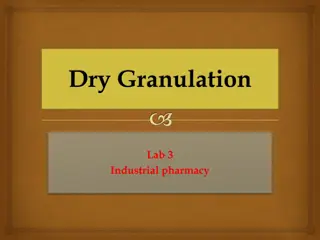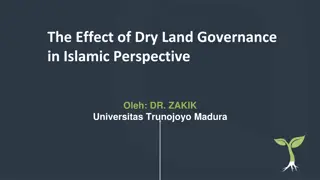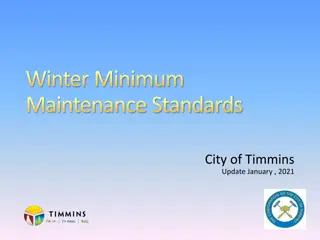Understanding Dry-Type Transformers: Classification and Maintenance
Dry-type transformers come in ventilated, non-ventilated, and sealed units, each with specific construction features and maintenance requirements. Ventilated transformers allow air circulation, non-ventilated operate in a sealed enclosure, and sealed units are self-cooled. Regular checks are essential to prevent contamination and ensure optimal performance. Maintenance tasks include inspecting isolation dampeners, cleaning cooling fans, and preventing moisture buildup. Proper care during shutdown periods is crucial to avoid insulation damage and failures.
Download Presentation

Please find below an Image/Link to download the presentation.
The content on the website is provided AS IS for your information and personal use only. It may not be sold, licensed, or shared on other websites without obtaining consent from the author. Download presentation by click this link. If you encounter any issues during the download, it is possible that the publisher has removed the file from their server.
E N D
Presentation Transcript
Dry - Type Transformers VG PATEL
TRANSFORMER ENCYCLOPAEDIA DRY TYPE TRANSFORMER Dry-type transformer classifications Dry-type transformers are classified as ventilated, non- ventilated, and sealed units, with each type detailed in the ANSI/IEEE C57.12.01-1989 standard A ventilated dry-type transformer is constructed so that ambient air can circulate through vents in the surrounding enclosure and cool the transformer core and coil assembly. A non-ventilated transformer operates with air at atmospheric pressure in an enclosure that does not allow ambient air to circulate freely in and out. A sealed transformer is self-cooled, with the enclosure sealed to prevent any entrance of ambient air. These transformers are filled with an inert gas and operate at a positive pressure. Sunday, September 29, 2024 2
TRANSFORMER ENCYCLOPAEDIA DRY TYPE TRANSFORMER The frequency of periodic checks will depend on the degree of atmospheric contamination and the type of load applied to the transformer. This is especially true for non-sealed transformers since ambient air and any contaminant dust or vapors it carries can contaminate the internal, electrically-stressed components. As routine inspections are made, the rate of accumulation of dust and moisture on the visible surfaces should serve as a guide for scheduling periodic maintenance. Thus, ventilated transformers will require more frequent periodic checks than non-ventilated units. Sealed transformers will require less frequent periodic checks than either type, because of their construction. Sunday, September 29, 2024 3
TRANSFORMER ENCYCLOPAEDIA DRY TYPE TRANSFORMER Isolation dampeners between the base of the transformer and the floor should be checked for deterioration. Cooling fans or auxiliary devices should be inspected and cleaned. Sunday, September 29, 2024 4
TRANSFORMER ENCYCLOPAEDIA DRY TYPE TRANSFORMER If the transformer is de-energized long enough so that it can cool to ambient temperature, make sure that the unit is kept dry. If the ambient air is very humid, you may have to heat the transformer with electrical strip heaters to avoid condensation of moisture on the winding insulation. This is very important because a large percentage of dry-type transformer failures occur after extended shutdowns, when the insulation is allowed to cool and moisture in the ambient air condenses on the insulation. Sunday, September 29, 2024 5
TRANSFORMER ENCYCLOPAEDIA DRY TYPE TRANSFORMER Pressure readings should be checked and recorded for transformers with sealed tank construction. The ambient temperature, time of day, and loading conditions should be recorded along with the pressure. Audible sound should be monitored, concentrating on the sound's characteristics as well as its level. Any noticeable change in the sound level or characteristics should be recorded. Significant changes could be indicative of loose clamping hardware, defective vibration isolators, over excitation, or possibly damage to the primary winding insulation. Sunday, September 29, 2024 6
TRANSFORMER ENCYCLOPAEDIA DRY TYPE TRANSFORMER Proper ventilation should be verified. Although few dry- type transformers are equipped with temperature gauges, the effectiveness of ventilation can be verified by measuring the air temperature at the inlet (which should be near the floor) to an enclosed room and then measuring either the ambient temperature of the air in the enclosed space or the temperature of the air at the exhaust (which should be in the upper part of the room). The average temperature of the room should not increase more than 40 [degrees] F over the incoming air and the exhaust should not increase more than 60 [degrees] F. Additional details on ventilation require- ments will be found in ANSI/IEEE C57.94. Sunday, September 29, 2024 7
TRANSFORMER ENCYCLOPAEDIA DRY TYPE TRANSFORMER Sealed units should be opened only when the need is indicated by loss of pressure, operating abnormalities, or at intervals as recommended in the manufacturer's instructions. With these units, periodic tests should be confined to: external inspections of the bushings and the enclosures. readings at external terminals should be taken of insulation resistance (IR), power factor (PF), and turns ratio. Sunday, September 29, 2024 8
TRANSFORMER ENCYCLOPAEDIA DRY TYPE TRANSFORMER IR testing: The IR of each winding should be measured using a megohm meter in accordance with Sections 10.9 through 10.9.4 of the ANSI/IEEE C57.12.91-1979 Standard, Test Code for Dry-Type Distribution and Power Transformers. The transformer should be de-energized and electrically isolated with all terminals of each winding shorted together. The windings not being tested should be grounded. The megaohm meter should be applied between each winding and ground (high voltage to ground and low voltage to ground) and between each set of windings (high voltage to low voltage). Sunday, September 29, 2024 9
TRANSFORMER ENCYCLOPAEDIA DRY TYPE TRANSFORMER Insulation PF testing Insulation PF is the ratio of the power dissipated in the resistive component of the insulation system, when tested under an applied AC voltage, divided by the total AC power dissipated. A perfect insulation would have no resistive current and the PF would be zero. The PF of insulation systems of different vintages and manufacturers of transformers varies over a wide range (from under 1% to as high as 20%). It's important that you establish a historic record for each transformer and use good judgment in analyzing the data for significant variations. ANSI/IEEE Standard C57.12.91 describes the performance and evaluation of insulation PF testing.23 Sunday, September 29, 2024 10
TRANSFORMER ENCYCLOPAEDIA DRY TYPE TRANSFORMER Acceptance tests (defined in Part 1, June 1994 issue, which concentrated on liquid-filled transformers) are those tests made at the time of installation of the unit or following a service interruption to demonstrate the serviceability of the transformer. This testing also applies to dry-type units. The acceptance tests should include: IR testing insulation PF measurement, turns ratio testing winding resistance measurements excitation current testing done. If you have a particular cause for concern, say a significant fault in the secondary circuit or a severe overload, you should make an impedance measurement and possibly an applied voltage test. Sunday, September 29, 2024 11
TRANSFORMER ENCYCLOPAEDIA DRY TYPE TRANSFORMER DC applied voltage tests are often conducted in the field because DC test sets are smaller and more readily available than AC applied voltage sets. With DC tests, the leakage current can be measured and is often taken as a quantitative measure. However, DC leakage current can vary considerably from test to test because of creepage across the complex surfaces between windings and between windings and ground. The use of AC voltage is preferable since the transformer insulation structures were designed, constructed, and tested with the application of AC voltage intended. Sunday, September 29, 2024 12
TRANSFORMER ENCYCLOPAEDIA DRY TYPE TRANSFORMER Impedance testing An impedance test may be useful in evaluating the condition of transformer windings, specifically for detecting mechanical damage shipment or a service fault on the output side that caused high fault currents to flow through the transformer windings. Mechanical distortion of the windings will cause a change in their impedance. To maximize the effectiveness of this test, you should take a measurement during the installation to establish a benchmark value. following rough transformer's initial Sunday, September 29, 2024 13
TRANSFORMER ENCYCLOPAEDIA DRY TYPE TRANSFORMER CAST RESIN DRY TYPE TRANSFORMER Sunday, September 29, 2024 14
TRANSFORMER ENCYCLOPAEDIA DRY TYPE TRANSFORMER MANUFACTURING PROCESS OF DRY TYPE TRANSFORMER WINDINGS CASTINGS CUTTING AND DRESSING ASSEMBLY Sunday, September 29, 2024 15
TRANSFORMER ENCYCLOPAEDIA DRY TYPE TRANSFORMER CHARECTERISTIC FEATURES 1) Maintenance free nature 2) Resistance against temperature fluctuation 3) Space Saving 4) Immediate switch on 5) High overload capacity 6) Lower losses and higher efficiencies 7) Higher reliability 8) Moisture proof Sunday, September 29, 2024 16
TRANSFORMER ENCYCLOPAEDIA DRY TYPE TRANSFORMER CRGO (Cold Rolled Grain Oriented Silicon steel) It is used to build the core. Grain of CRGO is oriented in the direction of rolling BURR LEVEL The sheets undergo proper cutting and is then available in many shapes like trapezoidal, octagonal and hexagonal etc. But while cutting the edges of these sheets, there is some generation of rough surfaces, these are known as burr level. UNLACING OF CORE This is the phenomenon of removal of top end frame of the core assembly so that the coils can be mounted on core. Sunday, September 29, 2024 17
TRANSFORMER ENCYCLOPAEDIA DRY TYPE TRANSFORMER PROCESSING OF COILS 1) Moulds 2) Disconnecting Film 3) Surface Fleeze 4) Mat 5) Tap 6) Winding 7) Jacketing 8) Segment 9) Encapsulation plant 10) Epoxy 11) Oven 12) Terminal plate Sunday, September 29, 2024 18
TRANSFORMER ENCYCLOPAEDIA DRY TYPE TRANSFORMER What is a dry transformer? Types and standards Cast coil transformers for special applications Vacuum cast coil strong points A revolutionary concept Main advantages The most economical The product basic range Vacuum cast range Standard technical features Short facts about the vacuum cast coil technology Environmental, climatic & fire classes Vibration proof Environmental classes E2 & one step forward: E2+ Features switching off endurance test Standard accessories Temperature control devices and sensors Special accessories Furthermore, any option is available See our advantages Sunday, September 29, 2024 19
TRANSFORMER ENCYCLOPAEDIA DRY TYPE TRANSFORMER What is a dry transformer? A transformer which does not use any kind of liquid for cooling, it has windings encapsulated under Vacuum, in epoxy resin reinforced with glass net. It is the most technologically advanced design for extreme conditions. Transformers for optimum space utilization, and special requirements. These transformers meet strict parameters with respect to electrical system demands, are virtually maintenance free and are manufactured in accordance with industry and international standards including, IEC 60076-11, ISO 9001 and ISO 14001. Sunday, September 29, 2024 20
TRANSFORMER ENCYCLOPAEDIA DRY TYPE TRANSFORMER Vacuum cast coil strong points Vacuum cast coil transformers are according to International standards. Stronger resistance against short-circuit stress. Superior behaviour on load changes (thermal). Linear distribution of BIL. Highest possible security against cracks on coils. No silicone during coil manufacturing. Better performance under dynamic loads (mechanic). Better performance under severe ambiental conditions (exceeding E2). More suitability for extreme environmental conditions. Sunday, September 29, 2024 21
TRANSFORMER ENCYCLOPAEDIA DRY TYPE TRANSFORMER V alued points A ll accesories available C ertifications proving our quality U nder vacuum benefits (Very low partial discharges) U ndercut (New materials) M aintenance free C apable of withstanding all conditions (C2,E2+) A ttractive appearance S afety T ailored solutions C ontinuos improvements (> 52 kV level insulation) O vervoltage transient design (> 20,000 on/off) I mpulse lightening for high tensions (250 kV BIL) L onger life (Class H) Sunday, September 29, 2024 22
TRANSFORMER ENCYCLOPAEDIA DRY TYPE TRANSFORMER Main advantages: safe and environ- mental friendly Reduced environmental contamination. Zero risk of leakage of flammable or contaminating substances. Environmental safe in production. Well suited to damp and contaminated areas. No fire hazard. Transformers are non flammable and self-extinguishing. High resistance to short circuits. High capacity to support overloads. High performance in dealing with seismic phenomenon. Capable of withstanding the most severe of rolling and vibrating conditions. Sunday, September 29, 2024 23
TRANSFORMER ENCYCLOPAEDIA DRY TYPE TRANSFORMER The lowest partial discharge value thanks to the most advanced casting technology. The typical partial discharges is below 5pC (maximum allowed 10pC). Epoxy resin cast under vacuum avoids entry of moisture and protects against aggressive environ- ments. Unique coil finishing provides smooth surface eliminating dust accumulation. Self-extinguishing in the event of fire or arcing and no gases released with potential danger. Step lap core configuration granting lower values of no load losses, no load current and noise level. Sunday, September 29, 2024 24
TRANSFORMER ENCYCLOPAEDIA DRY TYPE TRANSFORMER The best alternative due to: Fire hazard Safety for people and property Respect for natural life Suitable to operate in humid or heavily polluted environments (E2). Suitable for operation, transport and storage at ambient temperatures down to minus 25 C (C2). Restricted flammability, self fire extinction (F1). Emission of toxic substances and opacity of fumes is minimized (F1). Partial discharges bellow 5 pC in average. Withstand the same impulse test even for exposed situation. Have more ability to withstand thermal and dynamic short circuit effects. Mechanically stronger, safer against vibrations, earthquakes, etc.. No liquid, neither leaks and no risk of polluting spills. Sunday, September 29, 2024 25
TRANSFORMER ENCYCLOPAEDIA DRY TYPE TRANSFORMER Main advantages Aluminium foil disk in High Voltage winding Step-lap configurate Possibility to install any kind of accesories High impulse withstand through foil-disk winding Lowest partial discharge (>5 pC) due to epoxy resin casted under vacuum (horizontal process) Unique coil finishing: Smooth surface that eliminates dust acumulation Dust / pollution resistance thanks to the sealed technology High capacity to withstand overloads due to high thermal innertia Self- extinguish Axial short-circuit forces retained & hight short circuit withstand Radial short circuit forces retained Bidirectional wheels Sunday, September 29, 2024 26
TRANSFORMER ENCYCLOPAEDIA DRY TYPE TRANSFORMER ADVANTAGE OF THIS TYPE OF TRANSFORMERS Easy installation Oil free, so, no leakage problem Fire safety: Internal arcing from electrical faults and externally applied flames do not cause transformers to burst or burn. Oil-collecting pits, fire equipment, etc. are not required as applicable for oil- filled electrical equipment. They have similar noise levels to comparable oil-filled transformers. Taking all indirect cost reductions into account, they are also frequently cost-competitive. By virtue of their design, transformers are completely maintenance-free for their lifetime. walls, fire extinguishing Sunday, September 29, 2024 27
TRANSFORMER ENCYCLOPAEDIA DRY TYPE TRANSFORMER Dry transformers versus oil transformers Suitable to operate in humid or heavily polluted environments (E2). Suitable for operation, transport and storage at ambient temperatures down to minus 25 C (C2). Restricted flammability, self fire extinction (F1). Emission of toxic substances and opacity of fumes is minimized (F1). Partial discharges bellow 5pC in average. Withstand the same impulse test even for exposed situation. Have more ability to withstand thermal and dynamic short circuit effects. Mechanically stronger, safer against vibrations, earthquakes, etc.. No liquid, neither leaks and no risk of polluting spills. Sunday, September 29, 2024 28
TRANSFORMER ENCYCLOPAEDIA DRY TYPE TRANSFORMER The most economical Less space needed. Less civil work needed. No special safety features required. (fire detection) Maintenance free. Longer transformer life due to low thermal and dialectic ageing. Can be installed closer to the point of consumption reducing load cable losses. Optimal design subject to constant improvements in design as new materials become available. Sunday, September 29, 2024 29
TRANSFORMER ENCYCLOPAEDIA DRY TYPE TRANSFORMER Environmental, climatic and fire classes Environment E0 -- Normal indoor installation, no condensation, no considerable pollution. E1 -- Limited pollution, occasional condensation eg off circuit periods. E2 Heavy pollution, frequent condensation. Sunday, September 29, 2024 30
TRANSFORMER ENCYCLOPAEDIA DRY TYPE TRANSFORMER Vibration proof The vibration to which the transformer is exposed to during its lifetime, was summarized in an accelera- tion spectrum with the simulation of its life cycle loads. Multi-axis vibration tests, and shock tests were performed as per IEC 68-2-6/59, German edition EN 60068 parts 2-6 and 2-59 as well as particular customer s requirements. Extreme accelerations due to handling or harsh vibration were also considered in these tests. Sunday, September 29, 2024 31
TRANSFORMER ENCYCLOPAEDIA DRY TYPE TRANSFORMER FOLLOWING ACCESSORIES ARE USED FOR THIS TYPE OF TRANSFORMERS NOMEX insulation Super enamel copper conductor Winding temperature digital Casting blocks used in coil assembly and also used at core coil assembly time. Fiber glass sheet Fiber glass cylinder Lifting hooks RTD sensors Epoxy CT Marshaling box Kraft paper Fiber glass tap Special fan Bidirectional rollers Enclosure Sunday, September 29, 2024 32
TRANSFORMER ENCYCLOPAEDIA DRY TYPE TRANSFORMER IMPORTANT IS 1180 is not applicable, only IS 2026 is applicable Sunday, September 29, 2024 33
TRANSFORMER ENCYCLOPAEDIA OPEN FORUM Sunday, September 29, 2024 34
TRANSFORMER ENCYCLOPAEDIA THANQ Sunday, September 29, 2024 35
